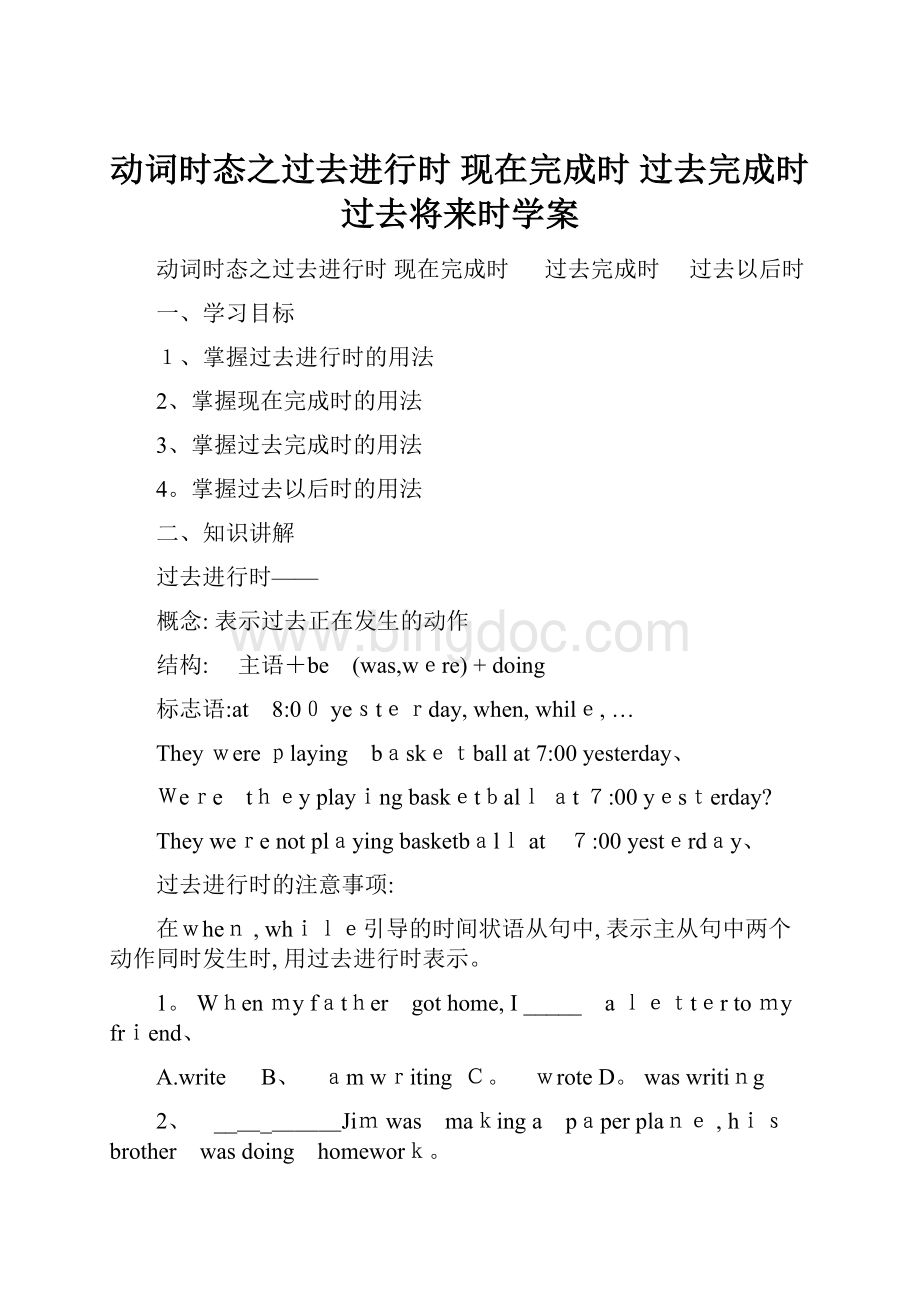动词时态之过去进行时 现在完成时 过去完成时 过去将来时学案Word文件下载.docx
《动词时态之过去进行时 现在完成时 过去完成时 过去将来时学案Word文件下载.docx》由会员分享,可在线阅读,更多相关《动词时态之过去进行时 现在完成时 过去完成时 过去将来时学案Word文件下载.docx(10页珍藏版)》请在冰点文库上搜索。

1。
Whenmyfather gothome,I_____ alettertomyfriend、
A.write B、 amwritingC。
wroteD。
waswriting
2、 _______Jimwas makinga paperplane,hisbrother wasdoing homework。
考点一:
过去的时间点所对应的延续动词的过去进行时态
―I calledyouthismorning,butnobody answered。
―I___theflowersinmygardenatthat time、
A、watered B、was watering C、 water
考点二:
上下文所决定的过去进行时态
—Why didn’tyoueandopen thedoorforme,dear?
- Oh, sorry,I_______________inthe kitchen。
I didn'
t hearyou、
A。
cookedB。
would cook C、 wascooking
现在完成时——
1、现在完成时的构成:
助动词have(has)+动词的过去分词。
注:
has用于第三人称单数,have用于其他所有人称、
2。
现在完成时的用法:
(1)现在完成时表示过去发生或差不多完成的某一动作对现在造成的影响或结果。
通常与表示包括现在在内的时间副词just, already,before,yet, never,ever等状语连用、
①Ihaveneverheard ofthatbefore、
② Haveyoueverriddenahorse?
③Shehasalreadyfinishedthework。
④ Haveyoumilked thecowyet?
Yes,Ihavedonethat already、
⑤I’vejustlost mysciencebook、
有时没有时间状语;
多是一般疑问句。
(2)现在完成时表示过去差不多开始,持续到现在,也许还会持续下去的动作或状态。
能够和表示从过去某一时刻延续到现在(包括现在在内)的一段时间的状语连用、如:
for和since,以及sofar, now,today,this week(month, year)等。
①Ihaven'
tseenherthesedays。
② Shehaslearnt English for3years。
③ Theyhavelivedheresince1990、
④Whathas happenedtotheUSA in thelast 350years?
(3)现在完成时还能够用在时间和条件状语从句中,表示以后某时完成的动作、
I’llgotoyourhomewhenIhave finishedmy homework、
Ifit has stoppedsnowinginthemorning,we’llgo tothepark。
现在完成时的注意事项:
havebeen(to)和havegone(to)的区别:
①have/has been(to)表示“曾经去过”某地,说话时此人特别估计不在那儿,差不多回来。
侧重指经历。
②have /hasgone(to) 表示某人“差不多去了"
某地,说话时此人在那儿,或估计在路上,反正不在这个地方。
试比较:
He hasbeentoBeijing。
他曾去过北京。
(人已回来,估计在这儿)
He has gone toBeijing、他差不多去了北京。
(人已走,不在这儿)
一般过去时与现在完成时之比较:
1、过去时表示过去某时发生的动作或单纯叙述过去的情况,强调动作;
现在完成时为过去发生的,强调过去的情况对现在的影响,强调的是影响。
2、过去时常与具体的时间状语连用,而现在完成时通常与模糊的时间状语连用,或无时间状语。
一般过去时的时间状语:
yesterday,lastweek,…ago, in1980,inOctober,justnow等具体时间状语
现在完成时的时间状语:
for,since,sofar,ever,never, just, yet, till/until,uptonow, inpastyears,always等不确定时间状语
例句:
Isawthisfilmyesterday、(强调看的动作发生过了。
)
Ihaveseenthisfilm、(强调对现在的影响,电影的内容差不多明白了、)
Shehasreturned fromParis、(她已从巴黎回来了。
Shereturned yesterday、 (她是昨天回来了。
)
He has beeninthe Leagueforthreeyears。
(在团内的状态可延续)
HejoinedtheLeaguethreeyears ago、 (三年前入团,joined为短暂行为。
注意:
句子中如有过去时的时间副词(如 yesterday, lastweek,in1960)时,不能使用现在完成时,要用过去时、
(错)Tomhaswritten alettertohisparentslast night、
(对)Tomwrotea lettertohisparentslast night、
延续动词与瞬间动词:
1)用于完成时的区别:
延续动词表示经验、经历;
瞬间动词表示行为的结果,不能与表示段的时间状语连用。
He haspleted thework、 他已完成了那项工作。
(表结果)
I’veknownhimsince then、 我从那时起就认识他了。
(表经历)
2) 用于till/until 从句的差异:
延续动词用于肯定句,表示“做……直到……”;
瞬间动词用于否定句,表示“到……,才……”。
Hedidn'
t eback until teno'
clock、他到10点才回来、
Hesleptuntilteno'clock、 他一直睡到10点。
表格对比:
请观察下边动词的转换-—
“过去某一动词对现在的影响”中的现在完成时态
I______my teachersincelastyear、Imisshimvery much、
A。
didn’tsee B、sawC。
haven’tseen
考点二 :
“经历”所采纳的现在完成时态
—Wouldyouliketosee the filmwith me?
—I'
msorryI____ittwice、
A.see B。
willsee C。
have seen D、amseeing
考点三:
表示“段”的时间状语决定的延续动词
—When didyoubuythesenew CDs?
-I____themfor twodays。
had B、haveboughtﻩﻩC、havehad
考点四:
havegoneto, havebeento,havebeenin…区别
— Iwant to returnthebookto Jack,butI can'
tfindhim。
- He___the library。
Youcanfind himthere、
A、has beento B、hasgonetoﻩC。
hasleft D。
wentto
过去完成时--
1、概念:
表示过去的过去。
那时往常 那时 现在
其结构是:
had+过去分词
过去完成时的用法:
(1)过去完成时表示过去某一时刻或者某一动作之前完成的动作或状态;
句中常用by, before,until,when等词引导的时间状语。
Bytheend of lastyearwehadbuiltfive new houses、
I hadlearnt5000wordsbefore Ienteredtheuniversity、
(2)过去完成时的动词还能够表示过去某一时刻之前发生的动作或者状态持续到过去某个时间或者持续下去。
Before heslept, hehadworkedfor12hours、
(3)在told, said, knew,heard,thought等动词后的宾语从句。
Shesaid(that)shehad neverbeento Paris。
(4)在过去不同时间发生的两个动作中,发生在先,用过去完成时;
发生在后,用一般过去时。
Whenthepolicearrived,thethieves hadrunaway。
(5)表示意向的动词,如hope,wish,expect,think,intend, mean,suppose等,用过去完成时表示“原本…,未能…”、
Wehad hopedthatyouwoulde,butyou didn'
t、
(6)过去完成时的时间状语before,by, until, when,after, once,assoonas。
Hesaidthat hehadlearned someEnglish before、
Bythe time hewastwelve,Edisonhad began tomake alivingbyhimself、
Tomwas disappointedthatmostoftheguests hadleft whenhearrived at the party、
用一般过去时代替完成时:
1)两个动作如按顺序发生,又不强调先后,或用then,and,but等连词时,多用一般过去时。
Whenshe sawthemouse, shescreamed、
Myaunt gavemea hatandIlostit、
2)两个动作相继发生,可用一般过去时;
如第一个动作需要若干时间完成,用过去完成时、
When Iheardthenews,Iwasveryexcited、
3) 叙述历史事实,可不用过去完成时,而只用一般过去时。
Ourteacher toldus thatColumbus discoveredAmericain 1492。
过去以后时-—
1、基本概念:
过去以后时表示从过去的某一时间看将要发生的动作或存在的状态、它是一个相对的时态,即立足于过去某时,从过去的某一时间看马上发生的情况就要用这一时态。
Hesaidhismotherwouldbuy a bike forhim、
Mybrothertoldmehewouldn'
tbelieveJack anymore、
Would itbe allrightif heknewhis illness?
基本形式:
would/should+动词原形
(其中would用于各种人称,should常用于第一人称)
Theyweresuretheywould winthefinalvictory、
他们坚信会赢得最后胜利、
Hedidn'
texpectthatwe should(would)all bethere、
他没想到我们都在那儿。
上述两个例句中的宾语从句谓语wouldwin和should(would)be分别与其主句谓语 weresure 和 didn'texpect相对应。
过去以后时的一些其他表达形式:
1、was/were+goingto+动词原形
Hesaidhewasgoing totry、他说他准备试试。
2、was/were+to+动词原形
Theysaidtherailwaywastobeopenedto trafficonMayDay、
他们说这条铁路将在五一节通车、
3、was/wereabout+动词原形
Wewereabouttogo outwhenitbegantorain、
我们刚要出去天(突然)下起雨来、
4、过去进行时(一般多为动作概念较强的动词如:
go,e,leave,start,open,begin 等)也可用于表示以后、
I didn'
tknowwhentheywereingagain、
我不明白他们什么时候再来。
过去以后时的注意事项:
1、在时间和条件状语从句中,常用一般过去时来表示过去以后时、
Hesaidhewoulde tosee youwhenhehad time、
他说他有时间就来看望您。
2、“would+动词原形"
可表示过去习惯性的动作。
此时,不管什么人称,都可用would、
Whenhe wasa childhewould getupearly。
他年幼时,总是特别早起床、
例题:
Theoldman_____ two daysafterhehadbeen senttohospital、
died B、would die C。
haddied D、 has died
2、OldMcDonaldgaveupsmokingforawhile,butsoon____ to hisoldways、
A、returnedB、returns C、 wasreturningD。
hadreturned
3、I__myson_____adoctor,buthewasn’tgoodenoughatscience、
hoped;
wouldbeeﻩB、hadhoped;
wouldbee
C、 hadhoped;
willbee ﻩ D、hope;
willbee
4、I_____totakeagoodholidaythis year, butIwasn’tableto get away、
A、hope B。
have hoped ﻩC、 hadhopedD。
hoped
5、Helen____herkey in theofficesoshehad towaituntil herhusband_____home、
A、hasleft;
es ﻩﻩB、left;
hade
C。
hadleft;
came ﻩﻩ D。
hadleft;
woulde
6、Wewereallsurprisedwhen he made itclearthathe ____office soon、
leaves B、wouldleave C、left D。
hadleft